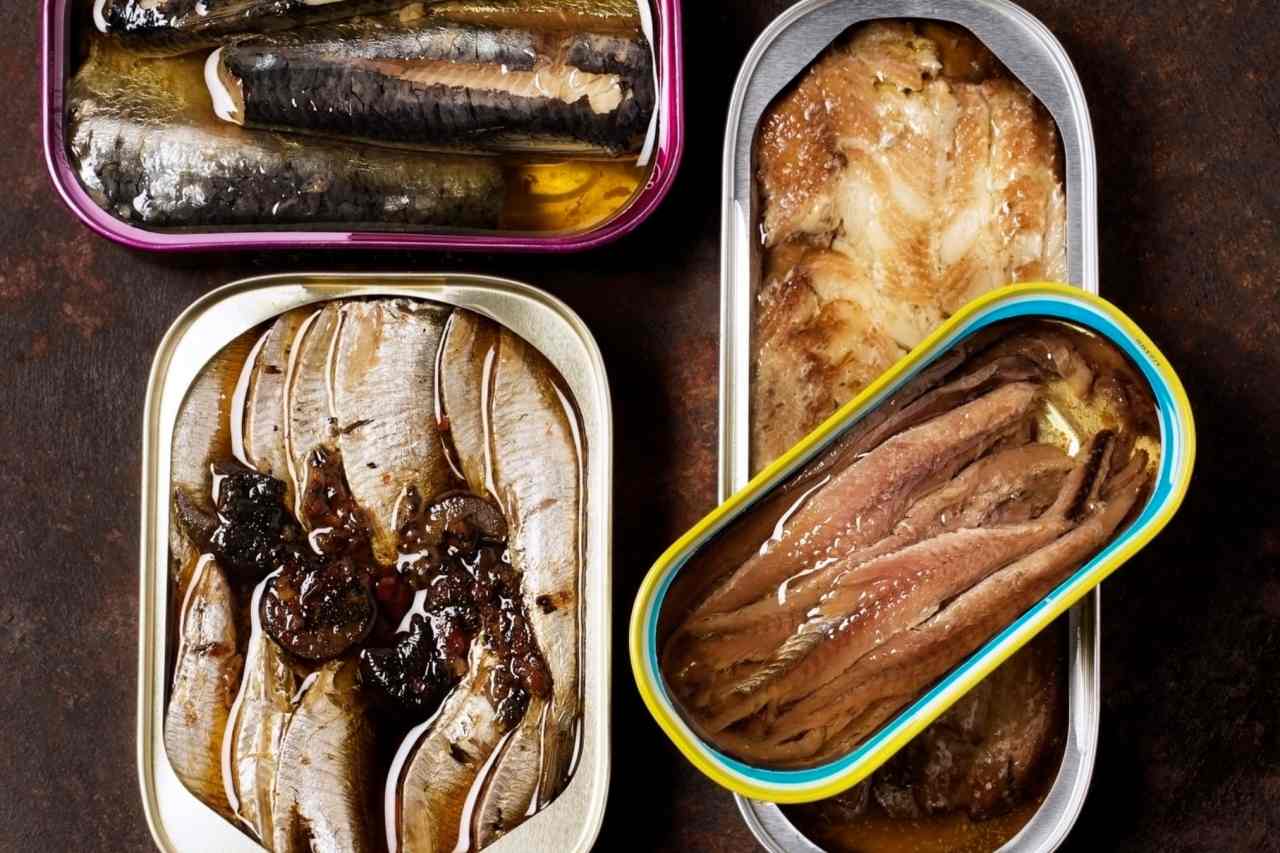With nutritionists and well being specialists telling everybody to construct their meals and snacks round entire meals and avoid processed ones, it could be simple to suppose that something that is available in a can isn’t the healthiest alternative. However that’s not all the time the case.
The confusion is completely comprehensible as a result of “processed” is a catch-all time period with quite a lot of unhealthy press tied to it, however there are numerous levels of processing. Positive, it’s clever to restrict your consumption of ultra-processed meals that include baggage like sugars, refined grains, sketchy fat and elements like emulsifiers and preservatives you wouldn’t often prepare dinner with at house. However some processed meals could make mealtime simpler and more healthy. Working example: canned fish.
We all know what you’re considering, nevertheless it’s not only for faculty college students — canned fish is a handy packaged meals you may be ok with shopping for and consuming often. Salmon, sardines, tuna and others are dietary heavy hitters that many individuals wrongly dismiss. Not ought to it’s your final resort for protein in your pantry.
Right here’s the whole lot it’s good to find out about this underrated seafood and why you need to take into account the canned fish aisle in case you’re trolling for tonight’s dinner.
1. You’ll Save Some Money
Canned fish can appear a lot much less attractive than contemporary choices, however in case you’re attempting to maintain your grocery invoice beneath management on this new actuality of rising meals prices, then seafood packed into tins generally is a rather more budget-friendly possibility.
When you go by the 2020-2025 Dietary Pointers for Individuals, adults ought to goal for 2 4-ounce servings of seafood per week. Many specialists suggest consuming a minimum of 12 ounces per week. Chipping away at this requirement utilizing canned fish is extra economical than solely counting on contemporary fish the place costs have been rising sharply of late. Canned fish may also final years in your pantry earlier than making their method into your tummy, whereas the clock is ticking on contemporary seafood as quickly as you convey it house.
2. It’s An Straightforward Method to Load Up on the Greatest Fat
You dropped some canned fish into your buying cart — superior, you’re that a lot nearer to reaching your omega-3 fatty acid wants.
The very best proof accessible suggests we eat a day by day common of 250 to 500 milligrams of the long-chain omega-3 fat EPA and DHA for higher well being. Canned sardines and mackerel ship an Olympic-sized punch of those omega-3 fatty acids, with about 1,300 milligrams in a 3-ounce serving. Sockeye salmon in a can affords up a minimum of 1,000mg of the mega-healthy fat, which is a number of instances greater than you’ll get from tilapia. So in case you merely consumed a 3-ounce serving of sardines and two 3-ounce servings of sockeye salmon in every week, it could work out to a wholesome day by day common. Though, the omega-3 content material of fish like mackerel and herring can fluctuate primarily based on the season once they’re caught.
A current research in Nature Communications found that individuals who had higher ranges of omega-3 fatty acids — particularly, eicosapentaenoic acid (EPA) and docosahexaenoic acid (DHA) which can be most simply present in a wide range of canned fish — had a 13 % decrease threat for all-cause mortality, in addition to a decrease threat for loss of life because of most cancers, heart problems and different causes mixed, in contrast with these with decrease ranges. One other research from Tufts College in Boston suggests that folks could also be extra prone to age with out well being issues once they have increased blood ranges of those superhero fat. There are doubtless just a few explanation why these omegas may also help us stick round longer with good well being, together with reducing irritation, decreasing blood triglycerides and reducing blood stress.
When you’re trying to maximize your omega-3 consumption, remember that canned sockeye has about 30 % greater than canned pink salmon. Additionally, canned albacore (white) tuna provides roughly thrice as a lot omega fats as canned pink (gentle) tuna. It’s also possible to hunt down manufacturers like Wild Planet that convey to market increased omega-3 tuna as a result of they reel in additional fat-dense fish and prepare dinner their catch within the can somewhat than earlier than it’s packed. Which means much less of the wholesome fats (and taste) is thrown overboard.
Additionally, selecting fish packed in water or oil is not only a matter of private style and saving energy. There may be the possibility that among the omega-3 fat can leach into the encircling oil, which frequently is an affordable vegetable oil like soybean that you just’re doubtless dumping down the drain. The diploma of omega-3 loss has not been adequately examined, so it might or might not be a major quantity. One investigation, nevertheless, did discover that there was a excessive quantity of omega-3 fats discovered within the tomato pulp of canned mackerel, suggesting that there was an change between fish fillet and acidic pulp whereas they had been saved collectively throughout the cans. Which means it could be a clever transfer to eat the entire contents of the can on this case.
3. Seize Maintain of a Boatload of Protein
Having just a few cans of sardines and salmon on the shelf ensures a dependable supply of cheap protein even when the fridge is empty. They usually present a wallop of protein for relativity few energy. A 3-ounce serving of canned white tuna or sockeye salmon has about 20 grams of muscle-building protein, just about the identical you’d get by grilling up the identical quantity of rooster breast. Canned oysters, that are simple to toss onto any salad, supply up 13 grams of protein for a 2-ounce serving.
Past serving to your muscle groups get better and get extra outlined, dietary protein is very satiating, so together with high-protein sources like canned fish at meals may also help you keep full for longer to place the brakes on pointless snacking.
4. Canned Fish are Micro Magic
Past the omegas and protein, once you crack that lid open, you’ll even be digging into a variety of important micronutrients. Canned fish giant and small are dependable sources of phosphorus, vitamin B12, iron and selenium. One mineral that won’t get as a lot consideration because it deserves is selenium, which has been linked to a decrease threat for despair.
Selenium may also assist shield towards injury because of mercury publicity as a result of the selenium compound selenide binds mercury by forming mercury selenide. This neutralizes the dangerous results of the heavy steel. This could possibly be a giant motive why so many research present that increased fish consumption is useful for coronary heart and mind well being even when it leads to elevated mercury consumption.
One other vitamin perk is nice ranges of immune-boosting vitamin D in canned sardines, salmon, mackerel and herring. There aren’t too many go-to meals sources of vitamin D on the grocery store, so this dietary profit is very noteworthy. And the softened edible bones in canned salmon, sardines and anchovies are a supply of bone-benefiting calcium. Boneless choices can be found if that’s your choice and also you’re ensuring to get sufficient of this nutrient elsewhere in your food regimen.
Simply concentrate on sodium ranges. Whereas not tremendous excessive in sodium, some canned fish like tuna can have round 200 milligrams per serving. And canned fish is often considerably increased in sodium when in comparison with unseasoned contemporary or frozen. Most individuals ought to be searching for methods to trim among the sodium from their diets, if for no different motive than to assist beat the bloat. You’ll be able to examine sodium ranges amongst manufacturers and select these with much less. Or choose canned fish that state “No Salt Added.” Be leery of choices packed in tomato or different sauces as these are usually increased in sodium. However in case you eat a food regimen primarily based totally on entire meals, the sodium in a can of fish mustn’t put you within the day by day pink zone.
5. Fish Are Mind Meals
We already talked concerning the omega-3 bounty of canned fish, which is an important fatty acid for mind well being as they make up the membranes that encompass mind cells. However seafood can also be a dependable supply of phosphatidylserine, which is a phospholipid fatty substance that covers and protects the cells in your mind and carries messages between them. We’d like the stuff to maintain our minds sharp.
With that stated, we have to see extra high quality analysis to indicate that increased consumption charges may also help increase mind energy and stave off cognitive decline. Nonetheless, getting extra phosphatidylserine from canned fish looks as if a wise transfer.
6. You Can Fret Much less About Mercury
Mercury will get lots of press as a contaminant in some fish that may inflict injury on varied organs, together with mind, coronary heart and nervous system. As a result of mercury can cross the blood-brain barrier, fetuses are significantly weak throughout essential instances of improvement. However at typical consumption ranges for Individuals, maybe we must always fear much less about how a lot we could be getting from canned fish. A research in JAMA Community Open discovered that mercury publicity in adults at present consuming low to reasonable quantities of seafood was not considerably linked to the chance of heart problems loss of life or all-cause mortality. Moreover, blood mercury ranges related to present seafood consumption patterns weren’t attributed to untimely loss of life.
Nonetheless, in case you’re planning on including extra seafood — together with canned fish — to your food regimen, it’s a good suggestion to take the mandatory steps to be sure you’re not going into the pink zone for mercury consumption. Fortunately, Meals and Drug Administration (FDA) information exhibits that many canned fish species together with sardines, mussels, anchovies and salmon are usually low in mercury. So, you need to be capable to bump up consumption with out concern of inflicting a harmful buildup of mercury in bodily tissues (additionally, bear in mind the selenium-mercury connection mentioned above.) Value noting is that canned salmon might have much less mercury than contemporary or frozen salmon.
Issues are extra difficult for canned tuna, which typically is a fish species to concentrate on relating to this contaminant. Bigger and extra mature tuna accumulate increased ranges of mercury, whereas youthful and smaller species like yellowfin and skipjack — typically labeled as “chunk gentle” — are likely to have much less. For that reason, the FDA recommends limiting white albacore tuna consumption and mixing a wide range of different fish into our diets. It’s a bigger species of tuna, which implies it has eaten smaller fish that additionally comprise some mercury that in a course of referred to as “bio-accumulation” could cause a buildup of mercury in its flesh over time.
It is a larger situation for pregnant girls (or for many who try to get pregnant), nursing mothers and younger kids, as mind and nervous system improvement might be affected by mercury. Simply remember that any canned tuna can have much less mercury than different contemporary forms of giant predatory fish, like Bluefin and bigeye tuna, shark, swordfish and king mackerel. This chart from the FDA helps you select which fish to eat and the way typically primarily based on mercury content material.
If canned tuna is the popular catch of the day, you may enormously restrict your mercury by splurging on cans from smaller corporations like Wild Planet and Raincoast Buying and selling, which pack in smaller tuna which have soaked up fewer toxins. The model SafeCatch exams each wild tuna and salmon they course of to ensure that it accommodates a number of instances decrease mercury ranges than the FDA restrict. For this reason it’s the tuna alternative from the American Being pregnant Affiliation.
7. BPA-Free Is Now the Norm
BPA, or Bisphenol-A, is a plastic-based lining that was invented within the late 1800s to function a barrier between meals and tin cans to assist lower corrosion and meals contamination. Quick-forward many years later, and this endocrine-disrupting chemical has been prompt to be a contributing issue to a variety of well being woes together with coronary heart illness and even weight achieve with excessive quantities of publicity. (It’s value noting that the FDA has deemed BPA protected at typical consumption charges. That means not centering your food regimen round simply canned meals.)
Fortunately, most manufacturers of canned fish, together with the mega-ones like Bumblebee, have now eradicated BPA from their cans. In fact, the query stays what have they changed the chemical with, and if there’s any motive to additionally fret about no matter that is leaching into your tuna salad. When you’re nonetheless involved about BPA publicity, you may search the Environmental Working Group’s Meals Scores website to seek out out if a model of canned fish you want is suspected to make use of BPA or has another pink flags, together with ingredient considerations.
8. It’s Straightforward to Go Wild And Sustainable
When you’re within the wild fish camp, it’s good to know that the overwhelming majority of canned fish hails from wild-caught shares and never aquaculture. This consists of canned salmon that the majority typically is sourced from sustainable Alaskan fisheries. Many individuals really feel that wild-caught fish are superior to their farmed counterparts due to their capability to develop and feed in an natural atmosphere. However there at the moment are loads of well-performing farmed fish choices which can be produced utilizing much less environmentally damaging strategies and don’t essentially play second-fiddle nutritionally to wild.
Relating to canned tuna, it’s ideally suited to hunt out choices the place the fish is caught utilizing smaller boats that make use of “pole-caught” methods as an alternative of huge nets or lengthy line strategies that may usher in lots of bycatch. A model’s web site is an effective place to seek out this data to see which choices are worthy of high-water marks for sustainability. It’s also possible to search for the Marine Stewardship Council (MSC) blue label on a product’s bundle or check-in with the Monterey Bay Aquarium Seafood Watch website to see the place your most ocean-friendly choices are. Spoiler alert: Alaskan canned salmon and canned sardines from the Pacific are “Greatest Selections.” Fortuitously, increasingly more canned fish manufacturers are specializing in moral and sustainable practices. However, nonetheless, there’s loads of greenwashing on the market.
9. It’s Versatile within the Kitchen
Not only for sandwiches, canned fish may also anchor an enormous variety of workday lunches and fast weeknight dinners. Use the meat in salads, soups, curries, quesadillas, frittatas, omelets, fried rice, pasta dishes and, after all, fish muffins. Use finely chopped anchovies so as to add an umami taste punch to salad dressings, pasta sauce and dips.
Nice Catches
Go fish for these manufacturers that rating excessive marks for vitamin, style and sustainability.
- King Oscar Royal Fillets Mackerel in Olive Oil with Lemon
- Wild Planet Sardines in Water
- SafeCatch Elite Chili Lime Wild Tuna
- Raincoast Buying and selling Sockeye Salmon with No Salt Added
- American Tuna Wild Albacore No Salt
Recipe: Oat Salmon Loaf
Canned salmon makes for a handy and nutritious swap for floor beef on this meatloaf.
Components
- 3 (6-ounce) cans pink or sockeye salmon, drained
- 2 giant eggs, frivolously overwhelmed
- 1 cup rolled or quick-cook oats
- 1 giant carrot, grated
- 1 shallot, finely chopped
- 2 garlic cloves, minced
- 1/2 cup chopped flat-leaf parsley
- Juice of 1/2 lemon
- 1/4 tsp salt
- 1/4 tsp floor black pepper
- 1/3 cup barbecue sauce
Instructions
Preheat oven to 350°F. In a big bowl, flake salmon with a fork and stir in eggs, oats, carrot, shallot, garlic, parsley, lemon, salt and pepper. Add salmon combination to a 9×5-inch greased loaf pan and unfold till the combination is effectively compacted. Bake for half-hour. Unfold on barbecue sauce and bake for one more 10 minutes. Let cool for a number of minutes earlier than unmolding. Makes 4 Servings.







